Beginner’s Guide: How to Use an Angle Grinder Safely and Efficiently

Angle grinders are versatile power tools that can be used for a variety of tasks, from cutting and grinding metal to polishing and sanding surfaces. However, they can also be dangerous if not used properly. In this beginner’s guide, we will walk you through the steps of using an angle grinder safely and efficiently.
First and foremost, it is important to wear the right protective gear when using an angle grinder. This includes safety glasses or goggles to protect your eyes from sparks and debris, as well as earplugs or earmuffs to protect your ears from the loud noise. You should also wear gloves to protect your hands from cuts and burns.
Before using the angle grinder, make sure to inspect the tool for any damage or defects. Check the cord and plug for any fraying or other signs of wear. If you notice any issues, do not use the grinder and have it repaired or replaced. Additionally, ensure that the grinding wheel or cutting disc is securely and properly attached to the grinder.
When using an angle grinder, always maintain a firm grip on the tool and keep both hands on the handles. This will help you maintain control and prevent accidents. It is also important to position yourself in a stable and balanced stance, with your feet shoulder-width apart. This will give you better control over the grinder and prevent you from losing your balance.
When grinding or cutting, always let the tool do the work. Do not apply excessive pressure or force on the grinder, as this can cause the wheel to wear out quickly or break. Instead, apply gentle and steady pressure, letting the grinder’s motor and the weight of the tool do the cutting or grinding. Remember to move the grinder in a smooth and even motion, avoiding sudden jerks or changes in direction.
Lastly, always unplug the angle grinder when not in use and before changing accessories. This will prevent accidental starts and ensure your safety. After using the grinder, take the time to clean it and inspect it for any damage or debris. Store it in a safe and dry place, away from children and pets.
By following these safety guidelines and using an angle grinder with caution, you can confidently tackle a wide range of tasks and complete them efficiently and effectively.
Getting Started: Understanding the Basics of an Angle Grinder
An angle grinder is a versatile power tool that is commonly used for cutting, grinding, and polishing materials. It consists of a motor, a handle, and a spinning disc or wheel. The disc or wheel can be made of various materials, such as metal or diamond, depending on the desired application.
Motor: The motor is the heart of the angle grinder. It powers the rotation of the disc or wheel, providing the necessary force to cut or grind materials. Most angle grinders have a variable speed control, allowing you to adjust the speed to suit the specific task at hand.
Handle: The handle of an angle grinder provides a comfortable grip and allows you to control the tool with precision. It is usually made of plastic or rubber, which helps to reduce vibrations and improve ergonomics. Some angle grinders have an adjustable handle that can be positioned for optimal comfort.
Disc or Wheel: The disc or wheel is the cutting or grinding attachment that is mounted on the motor shaft. It comes in various sizes and shapes, each designed for specific applications. For example, a cutting disc is thin and flat, while a grinding wheel is thick and round. It’s important to choose the right disc or wheel for the task to ensure safety and efficiency.
Safety Features: Angle grinders are equipped with several safety features to protect the user from potential harm. These may include a safety guard, which covers the disc or wheel and prevents debris from flying out during operation. Some models also have a spindle lock button, which allows for easy and secure disc or wheel changes.
Accessories: There are a variety of accessories available for angle grinders, such as cutting discs, grinding wheels, wire brushes, and sanding discs. These accessories can be easily attached and detached from the angle grinder, allowing for different applications and tasks.
Understanding the basic components and features of an angle grinder is essential before using the tool. Familiarize yourself with the motor, handle, disc or wheel, safety features, and available accessories to ensure safe and efficient operation.
Choosing the Right Angle Grinder: Size, Power, and Features
Size
When choosing an angle grinder, one of the first things to consider is the size of the tool. Angle grinders come in a variety of sizes, typically ranging from 4 to 9 inches. The size you choose will depend on the type of work you’ll be doing. Smaller grinders are lighter and more maneuverable, making them ideal for tasks that require precision and control, such as cutting or grinding in tight spaces. Larger grinders, on the other hand, are better suited for heavy-duty tasks, like cutting through thick metal or concrete.
Power
The power of an angle grinder is typically measured in watts or amps, and it determines how effectively the tool can handle different materials and tasks. Higher power ratings generally indicate a more powerful and versatile grinder. For light-duty tasks, like cutting thin metals or sharpening tools, a grinder with a lower power rating may be sufficient. However, for heavy-duty tasks, such as grinding thick metal or concrete, it’s advisable to choose a grinder with a higher power rating to ensure optimal performance and efficiency.
Features
Angle grinders come with a variety of features that can enhance their versatility and ease of use. Some common features to look out for include adjustable speed settings, quick-change guards, and adjustable handles. Adjustable speed settings allow you to control the speed of the grinder, which can be beneficial when working with different materials. Quick-change guards make it easier to switch between different cutting or grinding discs without the need for tools. Adjustable handles provide added comfort and control when operating the grinder, particularly during prolonged use. It’s important to consider your specific needs and preferences when choosing a grinder with these features.
Safety First: Essential Safety Precautions for Using an Angle Grinder
Wear Appropriate Safety Gear
When using an angle grinder, it is crucial to protect yourself by wearing the right safety gear. Always wear safety goggles or a face shield to protect your eyes from flying debris. Additionally, wear earplugs or earmuffs to prevent hearing damage from the loud noise produced by the angle grinder. It is also important to wear long sleeves, gloves, and work pants to protect your skin from sparks and the abrasive wheel.
Check the Grinder Before Use
Prior to using an angle grinder, it is essential to inspect it for any damage or defects. Check the power cord, switch, and handle to ensure they are in good condition. Make sure the abrasive wheel is securely installed and not cracked or damaged. Furthermore, check that the guard is properly positioned to provide maximum protection during operation.
Secure Your Workpiece
Before starting the angle grinder, you must secure your workpiece in a stable position. If possible, use clamps or a vise to hold the workpiece securely. This will prevent it from moving or shifting while you are using the angle grinder, reducing the risk of accidents. Never hold the workpiece with your hand or against your body while operating the grinder.
Use the Angle Grinder Correctly
Proper usage of the angle grinder is crucial for your safety. Make sure to hold the grinder with both hands and maintain a firm grip throughout the operation. Keep a safe distance between your body and the grinder, and never lean over the tool while it is in use. When cutting or grinding, always move the grinder in a smooth, controlled motion, and do not force the tool or push too hard on the workpiece.
Be Mindful of Sparks and Dust
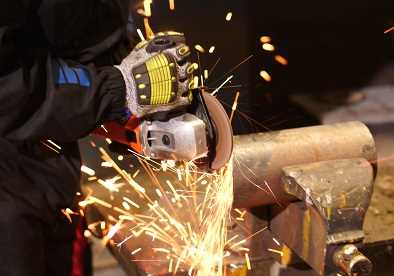
When using an angle grinder, sparks and dust can be produced. It is important to be mindful of these hazards and take precautions. Work in a well-ventilated area or wear a respirator to protect yourself from inhaling dust particles. Also, keep a safe distance from flammable materials, as sparks can ignite them. Have a fire extinguisher nearby and be prepared to use it if necessary.
Properly Store the Angle Grinder
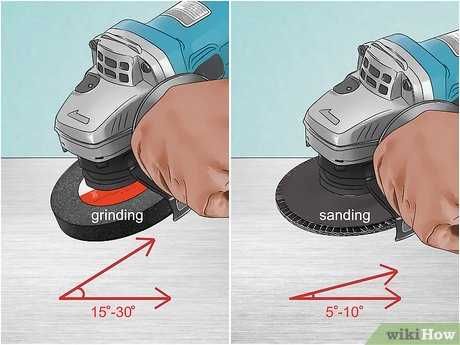
After using an angle grinder, it is important to store it properly to prevent accidents. Make sure the grinder is unplugged and the power cord is safely coiled. Store the grinder in a dry, secure area where it will not be knocked over or damaged. Additionally, store the abrasive wheels in a cool, dry place to maintain their integrity.
By following these essential safety precautions, you can ensure a safe and efficient experience when using an angle grinder. Always prioritize safety and take the necessary steps to protect yourself and others around you.
Selecting the Right Disc: Types and Uses of Angle Grinder Discs
Cutting Discs
Cutting discs are the most commonly used type of angle grinder discs. They are designed for cutting through various materials such as metal, steel, concrete, and tiles. Cutting discs come in different sizes and thicknesses, and it’s important to choose the right one for the task at hand. Thicker discs are generally more durable and suitable for heavy-duty cutting, while thinner discs provide more precision and are better for cutting thinner materials.
Grinding Discs
Grinding discs are used for removing material from a surface, such as smoothing rough edges or removing paint or rust. They are available in various grit sizes, with larger grit numbers indicating finer abrasiveness. Coarser grinding discs are more aggressive and suitable for heavy material removal, while finer discs are better for finishing and polishing surfaces. It’s important to choose the appropriate grit size based on the desired result.
Wire Brushes
Wire brushes are used for cleaning and removing rust, paint, and corrosion from metal surfaces. They are available in different bristle materials, such as steel or brass, and come in various shapes and sizes. Wire brushes can be used with angle grinders by attaching them to the grinder’s spindle. When using wire brushes, it’s important to wear appropriate protective gear, as loose bristles can become projectiles.
Flap Discs
Flap discs are versatile discs that can be used for both grinding and finishing tasks. They consist of multiple overlapping flaps of abrasive material, which provide a consistent finish and reduce heat generation. Flap discs are commonly used for deburring, blending, and finishing metal surfaces. They are available in different grit sizes, allowing for various levels of smoothness and surface preparation.
Diamond Blades
Diamond blades are designed for cutting through hard and abrasive materials such as concrete, stone, and tiles. They contain diamond particles embedded in the disc’s surface, which provide superior cutting performance and durability. Diamond blades are available in different sizes and types, including segmented blades for fast cutting, continuous rim blades for smooth cutting, and turbo blades for both fast and smooth cutting.
Safety Considerations
When selecting and using angle grinder discs, it’s important to prioritize safety. Always choose the appropriate disc for the task and ensure it is compatible with your angle grinder. Inspect discs for any damage or signs of wear before use. Wear protective gear such as safety glasses, gloves, and a face shield. Follow the manufacturer’s instructions and guidelines for the safe use of angle grinders and discs. Take breaks when necessary and don’t force the grinder or disc beyond its capabilities.
Handling and Operating an Angle Grinder: Proper Techniques and Grip
When handling an angle grinder, it is important to use proper techniques and maintain a secure grip. This will help ensure both safety and efficiency during use.
1. Proper Grip
Hold the angle grinder with both hands, keeping a firm grip on the handles. Use your dominant hand to control the on/off switch and the other hand to stabilize the tool. This will provide better control and minimize the risk of accidents.
2. Body Positioning
Stand in a stable position with your feet shoulder-width apart. Distribute your weight evenly to maintain balance and stability while operating the angle grinder. Avoid leaning excessively or putting strain on your back.
3. Correct Grinding Angle
Ensure that the angle grinder is held at the correct grinding angle to achieve the best results. The grinding wheel should be perpendicular to the workpiece, allowing for better control and efficient material removal.
4. Direction of Rotation
Pay attention to the direction of rotation of the grinding wheel. For most angle grinders, the wheel rotates clockwise. Make sure you position yourself in a way that allows you to operate the tool comfortably and safely while following the correct direction of rotation.
5. Use Both Hands
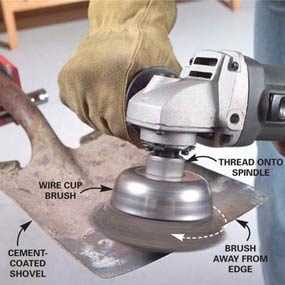
Always use both hands when operating an angle grinder. This provides stability and control, reducing the risk of accidents. Avoid using the grinder with just one hand, as it may cause the tool to be unbalanced and more difficult to control.
By following these proper techniques and maintaining a secure grip, you can use an angle grinder safely and efficiently, achieving optimal results in your projects while minimizing the risk of accidents or injuries.
Mastering Common Angle Grinder Tasks: Cutting, Grinding, and Polishing
1. Cutting
The angle grinder is a versatile tool that can be used for various cutting tasks. When it comes to cutting, the most important thing to keep in mind is safety. Use a cutting disc that is suitable for the material you are working with, whether it is metal, stone, or wood. Secure the workpiece firmly to prevent it from moving during the cutting process. Follow a straight line and apply steady pressure to achieve a clean and smooth cut. Always wear appropriate protective gear, including safety goggles and gloves, to protect yourself from sparks and debris.
2. Grinding
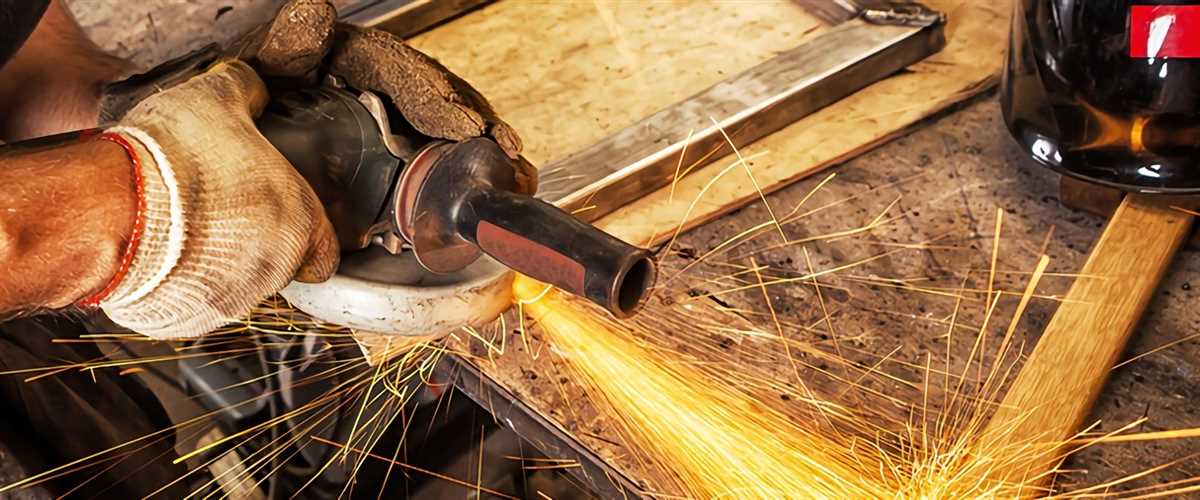
Grinding is another common task that can be easily accomplished with an angle grinder. To grind effectively, use a grinding disc that is suitable for the material you are working with, such as metal or concrete. Hold the grinder with a firm grip and position it at the correct angle to the workpiece. Apply even pressure and move the grinder in a back-and-forth or circular motion, depending on the desired result. Keep in mind that grinding generates a lot of heat, so it is important to take breaks and allow the grinder to cool down.
3. Polishing
The angle grinder can also be used for polishing surfaces, such as metal or stone. Start by selecting a polishing disc or pad that is appropriate for the material you are working with. Apply the polishing compound to the disc or pad and position the grinder at the correct angle to the surface. Move the grinder in a smooth and controlled motion, making sure to cover the entire area evenly. Keep in mind that polishing requires patience and precision, so take your time and make sure to achieve the desired level of shine and smoothness.
Overall, mastering common tasks with an angle grinder involves understanding the proper techniques, selecting the right discs or pads, and prioritizing safety. With practice and experience, you can become more proficient in cutting, grinding, and polishing various materials with an angle grinder.
Maintenance and Care: Keeping your Angle Grinder in Top Shape
Regular Cleaning
To keep your angle grinder in top shape, it’s important to regularly clean it after each use. Use a brush or compressed air to remove any dust, debris, or metal shavings that may have accumulated on the tool. Pay special attention to the ventilation slots and the area around the motor, as these are often the areas where dirt and particles can build up. Cleaning your angle grinder regularly will help prevent any damage or performance issues in the long run.
Inspect and Replace Worn Parts
As with any power tool, certain parts of an angle grinder can wear down over time. This includes the grinding disc, the brushes, and the safety guard. Regularly inspect these parts to ensure they are in good working condition and replace them as needed. A worn-down grinding disc, for example, can be less effective and more prone to accidents. By replacing worn parts promptly, you’ll not only maintain the efficiency and safety of your angle grinder, but also extend its lifespan.
Proper Storage
When not in use, it’s important to store your angle grinder properly to prevent any damage. Make sure the power cord is neatly wrapped and secured to avoid tangles or fraying. Store the grinder in a dry, clean area where it won’t be exposed to excessive moisture or dust. Consider using a dedicated storage case or bag to protect the grinder from impact and other potential hazards. Proper storage will help prolong the life of your angle grinder and ensure it’s ready for use whenever you need it.
Regular Maintenance Schedule
To ensure your angle grinder operates at peak performance, it’s a good idea to establish a regular maintenance schedule. This can include tasks such as lubricating moving parts, checking for loose or damaged screws, and testing the safety features. Refer to the manufacturer’s instructions for specific guidance on maintenance procedures. By sticking to a routine maintenance schedule, you can catch any issues early on and address them before they become more serious problems.
Follow Safety Guidelines
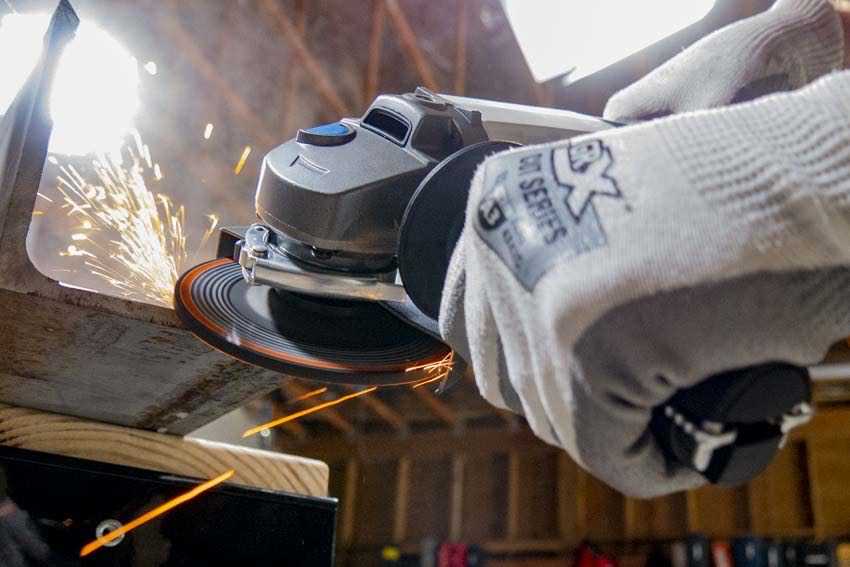
A well-maintained angle grinder is only as good as the person using it. Always follow safety guidelines when using your angle grinder and wear appropriate protective gear, such as safety glasses and gloves. Avoid using the grinder if you’re tired or distracted, as this can increase the risk of accidents. Regular maintenance and care go hand in hand with safe operation, ensuring that you can use your angle grinder safely and efficiently for years to come.
Putting Safety First: Safe Storage and Transportation of Angle Grinders
Proper Storage
When it comes to storing your angle grinder, it’s important to keep it in a secure location where it won’t be easily accessible to children or individuals who are not trained to use the tool. Store the grinder in a dry, cool place to prevent any moisture or extreme temperatures from damaging the tool or its components.
It’s also a good idea to store the angle grinder in a sturdy case or box that is specifically designed for transporting and storing the tool. This will not only protect the grinder from external damage, but it will also help prevent any accidental activation of the grinder’s power switch.
Transportation Safety
When transporting an angle grinder, always make sure the tool is completely powered off and unplugged. Secure the power cord and any additional accessories to prevent them from tangling or getting caught on anything during transportation.
If you’re using a vehicle to transport the angle grinder, place it in a secure position where it won’t move or slide around. Use straps or other means to secure the grinder in place and prevent it from falling or tipping over during transit.
Additional Safety Measures
In addition to proper storage and transportation, it’s also important to take some extra safety measures. Always keep the grinder’s safety guard intact and in good condition to protect yourself from any flying debris or accidental contact with the grinding wheel.
Before using the angle grinder, inspect it thoroughly to ensure there are no loose or damaged parts. Check the power cord for any signs of wear or damage, and replace it if necessary. Always wear appropriate personal protective equipment, such as safety glasses, gloves, and ear protection, to protect yourself from potential hazards.
By following these safety guidelines and taking the necessary precautions, you can ensure the safe storage and transportation of your angle grinder, minimizing the risk of accidents and injuries.
FAQ:
What is an angle grinder and what is it used for?
An angle grinder is a handheld power tool that is commonly used for cutting, grinding, and polishing materials such as metal, stone, and concrete.
Is an angle grinder dangerous to use?
An angle grinder can be dangerous if not used properly. It is important to follow safety precautions such as wearing protective gear, using the right attachments, and understanding how to control the tool.
What kind of protective gear should I wear when using an angle grinder?
When using an angle grinder, it is important to wear safety goggles, gloves, and a dust mask. It is also recommended to wear ear protection and a long-sleeved shirt to protect your arms from sparks and debris.
Can I use an angle grinder for cutting metal?
Yes, an angle grinder is commonly used for cutting metal. To cut metal with an angle grinder, you will need to use a cutting disc that is suitable for the type of metal you are working with.
How do I choose the right angle grinder for my needs?
When choosing an angle grinder, consider the size and power of the tool, as well as the type of tasks you will be performing. A smaller angle grinder with a lower wattage may be sufficient for light-duty tasks, while a larger angle grinder with a higher wattage is better suited for heavy-duty jobs.
Can I use an angle grinder for polishing?
Yes, an angle grinder can be used for polishing by using a polishing pad or attachment. However, it is recommended to have some experience with the tool before attempting to polish to avoid damaging the material.
Are there any safety tips I should know when using an angle grinder?
Yes, when using an angle grinder, always make sure to secure the workpiece, keep a firm grip on the tool, and maintain a safe distance from the blade. It is also important to be aware of any sparks or debris and to work in a well-ventilated area.
Video:











